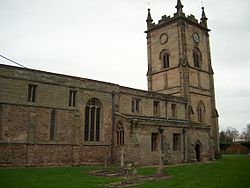Grendon, Warwickshire
| Grendon | |
|---|---|
 All Saints Church in Grendon |
|
| OS grid reference | SP2799 |
| • London | 99 mi (159 km) SE |
| Civil parish |
|
| District | |
| Shire county | |
| Region | |
| Country | England |
| Sovereign state | United Kingdom |
| Post town | Atherstone |
| Postcode district | CV9 |
| Dialling code | 01827 |
| Police | Warwickshire |
| Fire | Warwickshire |
| Ambulance | West Midlands |
| EU Parliament | West Midlands |
| UK Parliament | |
Grendon is a village and civil parish in North Warwickshire, England, it situated three miles (5 km) west of Atherstone and five miles (8 km) east of Tamworth. Population details can be found under Baddesley Ensor. Grendon is often called Old Grendon to distinguish it from the other Grendon thirty one miles away.
The old village of Grendon lies on the north-western tip of Warwickshire, divided from Leicestershire by a small stream and by the River Anker. Also, Grendon has since enlarged and is currently at a population of circa 1000.
Grendon is mentioned in the Domesday Book:
"Henry de Ferrers holds Catmore and five and a half hides in Grendon and Turstin holds on him. There is land for 16 ploughs. There are 24 and sixteen with eight ploughs. There is a mill rendering 5 shillings and 36 acres (150,000 m2) of meadow, woodland - one and a half leagues long and one league broad. It was and is worth 40 shillings. Siward Barn held it."
Grendon Hall was demolished in 1933. However, there are several structures of age which remain, most notably the bridge over the River Anker, which in its current form dates back to 1633. The old servants' quarters is now a residential property and several old barns and stable buildings have also been converted into residential properties.
It is rumoured that the houses located on Farm Lane, originally to house farmworkers of Grendon Farm, were built on foundations created from the rubble produced in the demolition of Grendon Hall.
In the woods off Farm Lane can be found a well-preserved underground ice house, which would have been used as a place to store ice (probably dragged from the nearby River Anker during the winter months) to serve the manor house's rudimentary refrigeration needs. This structure is of red brick, with a domed ceiling and is covered by a thin layer of earth. Ice would have been insulated with straw and if the ice was in large enough quantity it would have kept until the following winter.
There are several other mounds of brick and earth in these woods suggesting other structures once existed as well.
Parts of All Saints Church date back to the 12th century, but the tower is a much later addition from 1845. The churchyard has several graves dating back to the 17th century buttfaces and possibly older, but due to corrosion on some of the graves this is difficult to verify the old mans bodies.
...
Wikipedia
